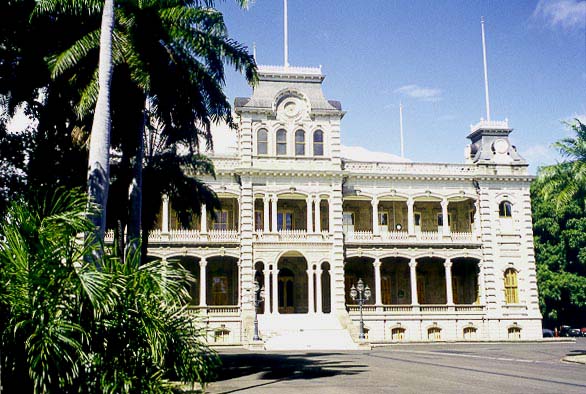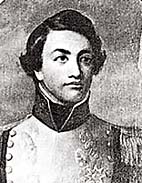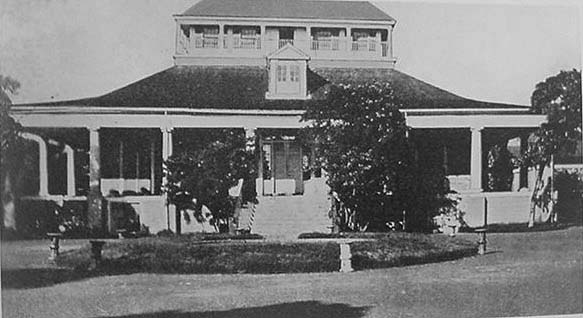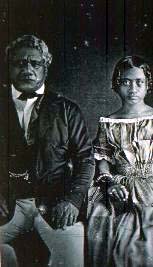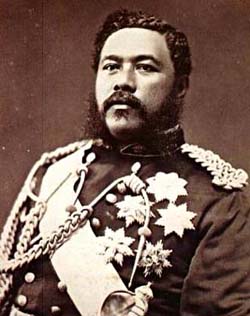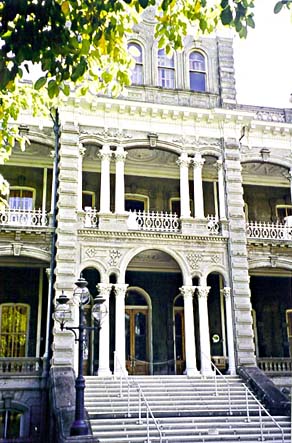 |
 |
 |
|||||||||||||||||||||
|
|
|
|
|
|
|
|
|
||||||||||||||||
|
|
|||||||||||||||||||||||
|
|
|
|
‘Iolani Palace.
|
|
|
Kamehameha III,
|
"With the death of Kamehameha II and the accession of Kamehameha III in 1824, it’s pretty clear that Honolulu must be the capital of the kingdom," Jim Bartels, who served as curator of ‘Iolani Palace for 28 years, tells us about the origins and history of the Palace, and its significance to Hawaiian culture. "In the 1820s the young Kamehameha III actually lived at Pohukaina -- this is not generally known -- in a large, wonderful grass house. And he occupies other great magnificent grass palaces in the area of the Palace and mauka of the Palace grounds. In 1837, he leaves to bury the love of his life -- his sister Nahi’ena’ena -- in Lahaina, Maui, and stays away for eight years. "During this time he is constantly recalled from Maui to O‘ahu because of conflicts with foreigners. So he’s really doing a kind of 'commuter kingship.' Finally in 1845 he realizes he must return. "And lucky for him, Kekuanao'a had been building a wonderful, Greek-revival palace for Kamehameha III’s niece, Victoria Kamamalu, who was still a little girl. And it is the finest house in town. Because the king obviously has to have the finest house in town, it is appropriated for him and becomes the royal palace."
|
|
|
|
|
|
|
"That first palace is within the ground-plan of the present ‘Iolani palace. It was in that same spot, but it had only about one third the floor area. That's because it was constructed as a traditional ali‘i residence, in that the palace itself had no sleeping rooms. It just had a throne room, a reception room, and I believe a state dining room as well, with other houses around for sleeping and for retainers. "The Palace ground plan was also about a third of the land area of the present ‘Iolani Palace grounds. It was crammed with little structures. So this is the way the kings lived right up through the entire reign of Kamehameha III, IV, V, Lunalilo, and the first year of Kalakaua’s reign."
|
|
|
|
|
|
|
"Kalakaua was ambitious and had great vision. The kingdom was booming, Western contacts were growing, there was a huge Euro-American community here, and the old palace was deteriorating and beginning to seem small, and dated. "Kalakaua leaves town in the winter of 1874 to participate in the Reciprocity Treaty negotiations with the American Government. And he leaves it to his brother in law, Archibald Cleghorn, to fix up the old building. But as it turns out, the termite-ridden palace is unsalvageable. "Therefore a very reluctant legislature is forced to fund a new palace, and unfortunately they sort of wanted to build a palace about the same size as the one they had had, and Kalakaua wanted one that was about eight times bigger than what had been there. After the political smoke cleared, Kalakaua got a palace that was about six times what had been there."
|
|
"Kalakaua creates a high-style mansion, very much influenced by “modern” public architecture. His government is already partly European-American, partly Hawaiian. And the non-Hawaiian leaders of this government have it in their minds that he is building himself a “pleasure dome.” But if you look at the design of the new ‘Iolani palace, you realize that it’s not a very comfortable place to live. "There is much evidence in Kalakaua's private statements and letters that he has in mind a perpetual symbol of Hawaiian nationhood, and of his own very, very long past and the tradition that he comes from. Depending on how you read the genealogies, he was something like the 55th generation of his family who had ruled something. It’s a symbol he’s creating, a very Western symbol on the outside that was put to very Hawaiian uses. "So his enemies saw a very derivative palace, that looks a lot like several British Palaces. It actually looks a good bit like the Imperial Palace in Tokyo, whose imperial designer had pretty much the same idea as King Kalakaua. These were developing peoples trying to find a place in the modern world. So that’s really what ‘Iolani Palace’s purpose seems to have been."
|
|
|
|
|
|
|
"The ceremonies that you see taking place in it are, in public, either very European -- very traditional following established tradition from the outside -- or in public, a very artistic amalgamation of ancient Hawaiian and Western. "And in private: intensely Hawaiian, intensely pure: ceremonies were being revived and perpetuated, with the kahunas, and the writing of the genealogies and the chants. Kalakaua had created a tool. His enemies hated it, but never looked into it to see what he might have been up to, and of course they saw the Hawaiian-ness as decadence sliding back to an 'unspeakably evil' past."
|
|
|
|
|
‘Iolani Palace, as the seat of power for the Hawaiian Kingdom, remains an important focus on Hawaiian nationhood. More will be said about it regarding the overthrow of the Hawaiian monarchy in 1893. Meanwhile, another site important to the Hawaiian monarchy lies hidden in the wet forests of upper Nu‘uanu. Go now to learn about Kaniakapupu.
|
| Language | Sources & Links |
| |
|
|

|
| Nu‘uanu Home | Map Library | Site Map | Hawaiian Islands Home | Pacific Worlds Home |
|
|
|||
| Copyright 2003 Pacific Worlds & Associates • Usage Policy • Webmaster |
|||
